OpenSeaMap
 | |
| Available in | English, German, French, Italian, Spanish, Russian |
|---|---|
| Owner | Community |
| Created by | members of the OpenSeaMap and OpenStreetMap community |
| Slogan(s) | The Free Nautical Chart |
| Website |
openseamap |
| Commercial | No |
| Registration | only required for contributors |
| Launched | 2009 |
Content license | Cc-by-sa (map), ODbL (data) |
OpenSeaMap is a software project collecting freely usable nautical information and geospatial data to create a worldwide nautical chart. This chart is available on the OpenSeaMap website, and can also be downloaded for use as an electronic chart for offline applications.
The project is part of OpenStreetMap. OpenSeaMap uses the same database, and complements the spatial data with nautical information. Such data may be used in accordance with the Open Database License. This ensures integration into printed materials, websites and applications is possible, without being limited by restrictive licenses, or having to pay fees.
History
The idea for the project was born at an OpenStreetMap developer conference in autumn 2008 at the Linux Hotel in Essen, Germany. A group of boaters and programmers decided to extend the coverage of OpenStreetMap to the seas and fresh water bodies. From the start the project has been worldwide and multilingual. By the end of 2009, the design and architecture of the project had been created, and a sample harbor "Warnemünde" was created to serve as an example chart. Since autumn 2009, a dedicated server has been available and the project is engaged in several collaborations with other free projects and organizations. In January 2010 OpenSeaMap was given a stand at boot Düsseldorf, Europe's largest boat show, allowing volunteers to present the project to a large audience of specialists for the first time.
Contents of the chart
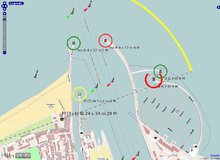
Charts will show lighthouses, lateral buoy, cardinal marks and other navigational aids. In the ports, facilities will be mapped (port wall, pier, walkways, docks, fueling stations, loading cranes, access roads, railway lines, ferry lines). Similarly, public authorities, shipbuilders and repairers, as well as sanitation and utility facilities will be displayed. The navigational attributes correspond to the international standard IHO S-57.
Water depths are not yet covered, because the database is not designed for three-dimensional coordinates. However, the plan is to eventually integrate a bathymetric model to describe the seabed.
The data are presented in multiple levels with OpenLayers on the base map of OpenStreetMap. The base map contains all the possible objects from OpenStreetMap.[1] OpenSeaMap includes additional layers such as aids to navigation, ports and temporary racing events.
Applications
The chart is for planning sailing and boat trips. It will also be useful as a guide for tourists. It is not intended to replace official charts.
- Online Map
- The map is available to any computer with an internet connection from the website OpenSeaMap.org. This map is updated daily.
- Offline Map
- The map can also be loaded on local data storage and can be used on any PC without internet access. This map will also permit use on other devices, such as GPS devices from Garmin and Lowrance, phones, and PDAs. The off-map is regularly updated, usually every week.
- App for iPad, iPhone, iPod touch
- The free App for OpenSeaMap works on iPad, iPhone und iPod touch.[2] The actual position is shown on the chart. Each downloaded chart is cached on the device and can be used without internet connection. With internet connection the app checks if there is a newer version of the chart. The Apple location search finds the fitting map section. The app works worldwide.
- Navigation
- With certain navigation programs, it is possible to display the current position directly on the chart via a connected GPS device, tracking a vessel's movement. An NMEA interface can run an autopilot and thus control the ship. Also, the display of AIS signals on the chart is possible. Appropriate navigation tools from the open source area are SeaClear and OpenCPN.
Internationalization
The site is translated into six languages: English, German, French, Italian, Spanish and Russian. The tools and the legends are available with a German, English and French interface. On the map the place names are always written in local language and script. The geographical coverage is worldwide. Depending on the region and the active cartographers, the coverage varies but is growing daily.
Timeliness
Data is stored in the database as soon as it has been entered, and is immediately available worldwide. Base map data is visible on the map after a few minutes. Navigational data is currently (2010) visible on the chart about two days after it has been entered.
Editing tools
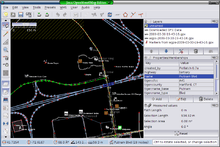
- Offline Editor JOSM with navigational enhancements
- JOSM is the default editor for OpenStreetMap. It has been extended for use on navigational charts with a plugin. It is written in Java and runs on multiple desktop platforms [3]
To edit you must register with a verified email address. Registration is free and will encourage high data quality. Read access does not require registration.
Other programs can access the XML-RPC interface to the data on the server in order to read and write OpenSeaMap data.
Harbor pilots
On the map are the world port, marina and anchorage. Via a pop-up window these are linked with a port guide containing detailed port information. This guide is organized as a Wiki and is shaped by the users. Included is the free wikiproject "SkipperGuide".[4] 5000 ports are accessible worldwide, including detailed descriptions of 600 marinas.
Weather information
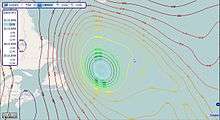
In worldwide weather charts there are shown weather data like wind speed, air pressure (isobars), etc., each actualised two to three times per day, and with weather forecast up to three days.
For each harbor there is a Meteogram with detailed wind forecasts and weather informations for eight days. Available weather data for wind direction, wind speed, air temperature, air pressure, relative humidity, cloudiness, precipitation. From this worldwide available data the captains can predict the marine weather.
Bathymetric data
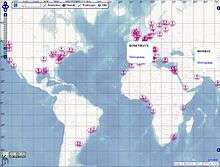
Worldwide, depths between 100 and 10,000 m are shown in a blue colour scale of 23 steps, together with depth shading. At higher zoom levels depth contours are also displayed. The data is given through cooperation with GEBCO and its bathymetric GEBCO_08-database.
Water depths by crowdsourcing


OpenSeaMap measures water depts by Crowdsourcing. Sailors, motor boaters, commercial shipping, divers, fishermen collect water depths between 0 and 100m with sounder and GPS. Divers work with a dive computer. Coastal water, lakes and rivers are surveyed. Result wil be an elevation model and derived depth lines.[5] Uploaded tracks are shown in the chart.[6] There is a discussion how crowd sourcing can support and enrich the systematic official measuring.
Wikipedia articles on the map
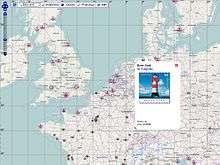
By "View Wikipedia-Links" OpenSeaMap displays all georeferenced Wikipedia articles worldwide as Icon. Until now 1.7 Mio. georeferenced articles are shown, in 41 languages, 260’000 in German and 740’000 in English (9.2011). By mouseover a popup is opened with title of the article and an informative picture. By click you will get the responding Wikipedia-article.
References
- ↑ map elements "Map Features "
- ↑ App for OpenSeaMap for iPhone, iPad and iPod touch
- ↑ JOSM Editor
- ↑ port manual "SkipperGuide"
- ↑ Wolfgang Bosch, Markus Bärlocher: OpenSeaMap – Wassertiefen per Crowdsourcing (PDF; 7,2 MB). Hydrographische Nachrichten 95, 30. Jahrgang, Juni 2013, Seiten 23-27.
- ↑ Water depths by crowd sourcing (Chart)
